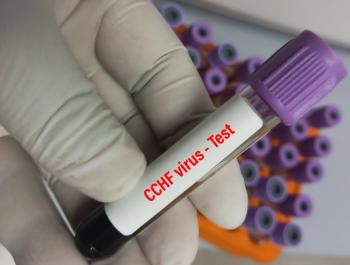Pharmacy Practice in Focus: Health Systems
- November 2025
- Volume 14
- Issue 6
Understanding Cyclobenzaprine Hydrochloride: An Emerging Therapy for Fibromyalgia
Key Takeaways
- Fibromyalgia affects 1% to 5% of the population, causing widespread pain, fatigue, and cognitive impairment, complicating diagnosis and treatment.
- Treatment guidelines recommend nonpharmacologic and pharmacologic strategies, with duloxetine, pregabalin, and milnacipran as FDA-approved options.
A new FDA-approved sublingual form of cyclobenzaprine HCl shows promising efficacy and tolerability in fibromyalgia.
Introduction
Fibromyalgia is a chronic pain disorder affecting an estimated 1% to 5% of the general population.1,2 It is primarily characterized by widespread musculoskeletal pain, stiffness, and tenderness; however, patients frequently experience additional symptoms such as fatigue, disrupted sleep, anxiety, and cognitive impairment, all of which can significantly impair daily functioning and quality of life.1,3 Although its pathophysiology remains poorly understood, fibromyalgia is classified among affective spectrum disorders, alongside conditions such as attention-deficit hyperactivity disorder, major depressive disorder, generalized anxiety disorder, and posttraumatic stress disorder.3 Current evidence suggests that fibromyalgia arises from a combination of abnormal pain signaling, genetic predispositions, autonomic nervous system dysfunction, environmental factors, and possibly chronic stress and disturbed sleep patterns.3 Because of its nonspecific symptoms and complex underlying mechanisms, diagnosis is often delayed, with many patients consulting multiple providers before receiving appropriate care and treatment.
Overview of Fibromyalgia Treatment Guidelines
Because fibromyalgia lacks a clear pathophysiological target, treatment guidelines have historically struggled to establish consistent recommendations. However, emerging evidence over the past decade has led to updated diagnostic and treatment algorithms. In 2016, the American College of Rheumatology introduced updated diagnostic criteria,4 with treatment guidelines being published by the American Academy of Family Physicians (AAFP) in 2023,5 the European Alliance of Associations for Rheumatology (EULAR) in 2017,6 and the Canadian Pain Society (CPS) in 2012.7 Although these guidelines differ in certain details, they share the same core principle in that treatment should include both nonpharmacologic and pharmacologic strategies, with nonpharmacologic approaches and patient education emphasized as first-line interventions.
Some examples of nonpharmacologic therapies include exercise, cognitive behavioral therapy (CBT), mindfulness, acupuncture, hydrotherapy, hypnotherapy, chiropractic care, and dietary modification.6,7 Among these, EULAR and CPS strongly endorse aerobic and resistance exercise and CBT, given robust evidence for pain reduction, though all approaches should be individualized based on the predominant symptoms the patient is experiencing.1,6,7
Pharmacological options for fibromyalgia are extremely limited. Only duloxetine (Cymbalta; Eli Lilly and Company), pregabalin (Lyrica; Viatris Inc), and milnacipran (Savella; AbbVie) are FDA approved for fibromyalgia.1 Other agents, such as amitriptyline, selective serotonin reuptake inhibitors (SSRIs), and cyclobenzaprine, are also used depending on patient symptoms.5-8 Amitriptyline, a tricyclic antidepressant, is conditionally recommended at low doses by both the AAFP and EULAR to improve sleep and pain, though anticholinergic adverse effects (AEs) remain a concern.5,6,8 Cyclobenzaprine, a centrally acting muscle relaxant, has a modest effect on pain with limited impact on sleep; the AAFP considers it an alternative to amitriptyline, whereas the EULAR issues only a weak recommendation, restricting use to patients with severe pain or sleep disturbances.5,6
Among the FDA-approved agents, duloxetine, a serotonin-norepinephrine reuptake inhibitor (SNRI) with stronger serotonergic activity, is considered first-line by the AAFP, whereas the EULAR recommends it primarily for patients with severe pain and comorbid depression.5,6 Pregabalin, which modulates voltage-gated calcium channels, is strongly recommended by both the AAFP and CPS due to consistent evidence of improved pain and sleep; however, it receives only a modest endorsement from the EULAR because of concerns regarding AEs and limited evidence strength.5-7 Milnacipran, another SNRI with stronger norepinephrine activity, is viewed by the AAFP as effective but less well tolerated compared with duloxetine, based on trial data.5,6,8
Conversely, SSRIs, nonsteroidal anti-inflammatory drugs (NSAIDs), and opioids are discouraged across all 3 guidelines. SSRIs lack convincing evidence for pain or sleep benefits and are not recommended as first-line therapy, though they may be used adjunctively in patients with depression or anxiety.5-7 NSAIDs have shown no benefit over placebo for fibromyalgia pain; the AAFP explicitly cites a Cochrane review, whereas the EULAR and CPS recommend use only in patients with coexisting inflammatory conditions, administering the lowest dose for the shortest duration possible.5-7 All guidelines strongly recommend against the use of opioids in fibromyalgia treatment, citing limited efficacy, risk of dependence and misuse, and potential worsening of hyperalgesia.5-7 If opioids are considered, tramadol may be used as a last-line option after failure of other therapies.6,7
Introduction to Tonmya
Tonmya (Tonix Pharmaceuticals Holding Corp) is a new sublingual formulation of cyclobenzaprine hydrochloride (HCl) that was approved by the FDA in August 2025 for fibromyalgia.9 This new sublingual route allows for rapid absorption and bypasses first-pass metabolism, which reduces systemic exposure and the likelihood of AEs when compared with the oral formulation.9 Because of the improved bioavailability, cyclobenzaprine HCl can be dosed at 5.6 mg rather than 10 mg for the oral tablet.9
Cyclobenzaprine works by blocking the 5-HT 2A receptor, leading to modulation of central pain pathways and eventual pain relief.9 In addition to pain relief, cyclobenzaprine also exhibits antihistamine activity, leading to sedation and improvement of sleep quality, which is a common symptom in fibromyalgia.9 However, due to its anticholinergic properties, it can lead to AEs such as dry mouth, constipation, and urinary retention.9 Additionally, cyclobenzaprine works in the noradrenergic pathways, which may play a role in improving headaches associated with fibromyalgia.9
Clinical Trials
RELIEF (NCT04172831)10 and RESILIENT (NCT05273749)11 are 2 trials that supported the FDA’s approval of sublingual cyclobenzaprine HCl. The RELIEF and RESILIENT trials were double-blind, randomized, placebo-controlled, multicenter trials that assessed the efficacy and safety of sublingual cyclobenzaprine HCl in patients with fibromyalgia. Patients were randomly assigned to receive 1 tablet (2.8 mg) each night for 2 weeks, then increase to 2 tablets (5.6 mg) per night for the rest of the trial. The trials lasted for 14 weeks of treatment, with patients having appointments for the trial on weeks 2, 6, 10, and 14. The placebo group would also take 1 or 2 tablets per night, according to their assigned time.10-13
The primary end point of the studies was to assess the average weekly pain score change at week 14 compared with the beginning of the trial. Some of the secondary end points were looking at the Revised Fibromyalgia Impact Questionnaire, Patient Global Impression of Change scale, and Patient-Reported Outcomes Measurement Information System sleep disturbance and fatigue scores, as well as changes in daily sleep quality.10-13
The RELIEF trial enrolled 503 patients, and the RESILIENT trial enrolled 457 patients.10,11 RELIEF demonstrated that approximately 46.8% of those receiving cyclobenzaprine HCl had 30% or more reduction in pain at 14 weeks, whereas the placebo group only had 34.9%. The weekly average daily pain scores also reflected cyclobenzaprine HCl’s superiority to placebo, with decreases of approximately 1.91 (95% CI, –2.15 to –1.68) and 1.51 (95% CI, –1.74 to –1.28) in these respective groups. The secondary end points were descriptive in nature, with cyclobenzaprine HCl demonstrating greater efficacy compared with placebo in each scoring system for improving symptoms.
Similar to RELIEF, RESILIENT showed cyclobenzaprine HCl’s superiority (45.9%) to placebo (27.1%) in achieving the primary end point. The average change from baseline at week 14 was approximately –1.8 for cyclobenzaprine HCl and –1.2 for placebo, with decreases of pain of 50% or greater being more common in the cyclobenzaprine HCl group (22.5%) than in the placebo group (13.3%).
AEs
AEs were common, with occurrences more frequent in those receiving cyclobenzaprine HCl (RELIEF: 59.7%; RESILIENT: 58.9%) than those receiving placebo (RELIEF: 46.3%; RESILIENT: 36.7%).10-13 Most of the symptoms were dose related and mild or moderate and more frequent in the cyclobenzaprine HCl group than in the placebo group. These AEs included oral hypoesthesia (RELIEF: 17.3% vs 0.4%; RESILIENT: 23.8% vs 0.4%), oral paresthesia (RELIEF: 5.6% vs 0.4%; RESILIENT: 6.9% vs 0.9%), and abnormal product taste (RELIEF: 4.4% vs 0.4%; RESILIENT: 11.7% vs 0.9%).10-13 Of note, AEs resolved within 60 minutes,12,13 and there was an approximate 1.3% chance of severe AEs with cyclobenzaprine HCl in the RESILIENT trial.13
Conclusion
Sublingual cyclobenzaprine HCl, a recently FDA-approved treatment for fibromyalgia, is a much-needed addition to the limited treatment options currently available to patients. Fibromyalgia is a chronic, devastating, and debilitating disease that significantly affects many different areas of a patient's quality of life. Clinical trials have demonstrated that cyclobenzaprine HCl is both safe and effective, has a favorable tolerability profile, and has minimal AEs reported over a 14-week treatment period. This approval marks an important advancement in the management of fibromyalgia, offering patients a new, groundbreaking therapeutic option for relief.
REFERENCES
Jones EA, Asaad F, Patel N, Jain E, Abd-Elsayed A. Management of fibromyalgia: an update. Biomedicines. 2024;12(6):1266. doi:10.3390/biomedicines12061266
Gyorfi M, Rupp A, Abd-Elsayed A. Fibromyalgia pathophysiology. Biomedicines. 2022;10(12):3070. doi:10.3390/biomedicines10123070
Ejaz KF, Wani R, Akbar A, et al. Pain management in fibromyalgia: evaluating the roles of pregabalin, duloxetine, and milnacipran. Cureus. 2024;16(12):e76631. doi:10.7759/cureus.76631
Wolfe F, Clauw DJ, Fitzcharles MA, et al. 2016 revisions to the 2010/2011 fibromyalgia diagnostic criteria. Semin Arthritis Rheum. 2016;46(3):319-329. doi:10.1016/j.semarthrit.2016.08.012
Winslow BT, Vandal C, Dang L. Fibromyalgia: diagnosis and management. Am Fam Physician. 2023;107(2):137-144.
Macfarlane GJ, Kronisch C, Dean LE, et al. EULAR revised recommendations for the management of fibromyalgia. Ann Rheum Dis. 2017;76(2):318-328. doi:10.1136/annrheumdis-2016-209724
Fitzcharles MA, Ste-Marie PA, Goldenberg DL, et al. 2012 Canadian guidelines for the diagnosis and management of fibromyalgia syndrome: executive summary. Pain Res Manag. 2013;18(3):119-126. doi:10.1155/2013/918216
Kia S, Choy E. Update on treatment guideline in fibromyalgia syndrome with focus on pharmacology. Biomedicines. 2017;5(2):20. doi:10.3390/biomedicines5020020
Tonmya – novel fibromyalgia treatment but will it deliver? American Fibromyalgia Syndrome Association. Accessed September 4, 2025.
https://www.fibromyalgiafund.org/tonmya-novel-fibromyalgia-treatment-but-will-it-deliver/ A study to evaluate the efficacy and safety of TNX-102 SL in patients with fibromyalgia (RELIEF). ClinicalTrials.gov. Updated August 8, 2022. Accessed September 4, 2025.
https://clinicaltrials.gov/study/NCT04172831 A phase 3 study to evaluate the efficacy and safety of TNX-102 SL taken daily in patients with fibromyalgia (RESILIENT). ClinicalTrials.gov. Updated January 22, 2025. Accessed September 4, 2025.
https://www.clinicaltrials.gov/study/NCT05273749 Lederman S, Arnold LM, Vaughn B, Kelley M, Sullivan GM. Efficacy and safety of sublingual cyclobenzaprine for the treatment of fibromyalgia: results from a randomized, double-blind, placebo-controlled trial. Arthritis Care Res (Hoboken). 2023;75(11):2359-2368. doi:10.1002/acr.25142
Lederman S, Arnold LM, Vaughn B, Engels JM, Kelley M, Sullivan GM. Pain relief by targeting nonrestorative sleep in fibromyalgia: a phase 3 randomized trial of bedtime sublingual cyclobenzaprine. Pain Med. Published online July 8, 2025. doi:10.1093/pm/pnaf089
Articles in this issue
15 days ago
Looking Forward to 2026: Do More With LessNewsletter
Stay informed on drug updates, treatment guidelines, and pharmacy practice trends—subscribe to Pharmacy Times for weekly clinical insights.



















































































































































































































